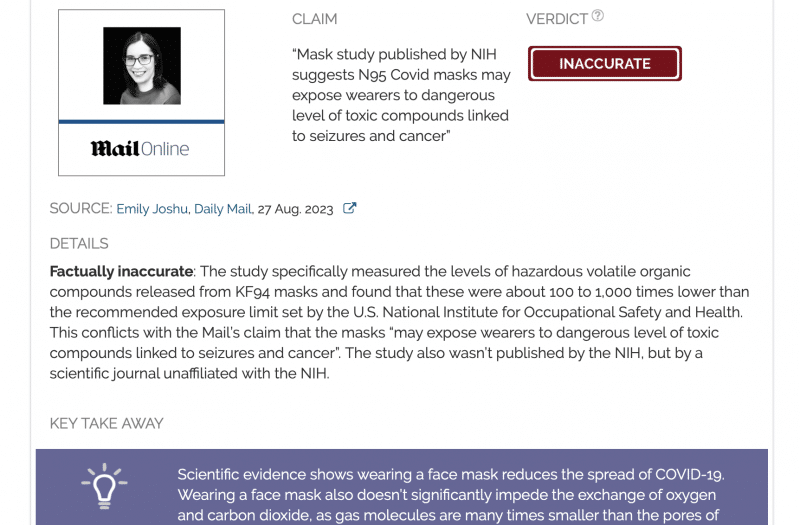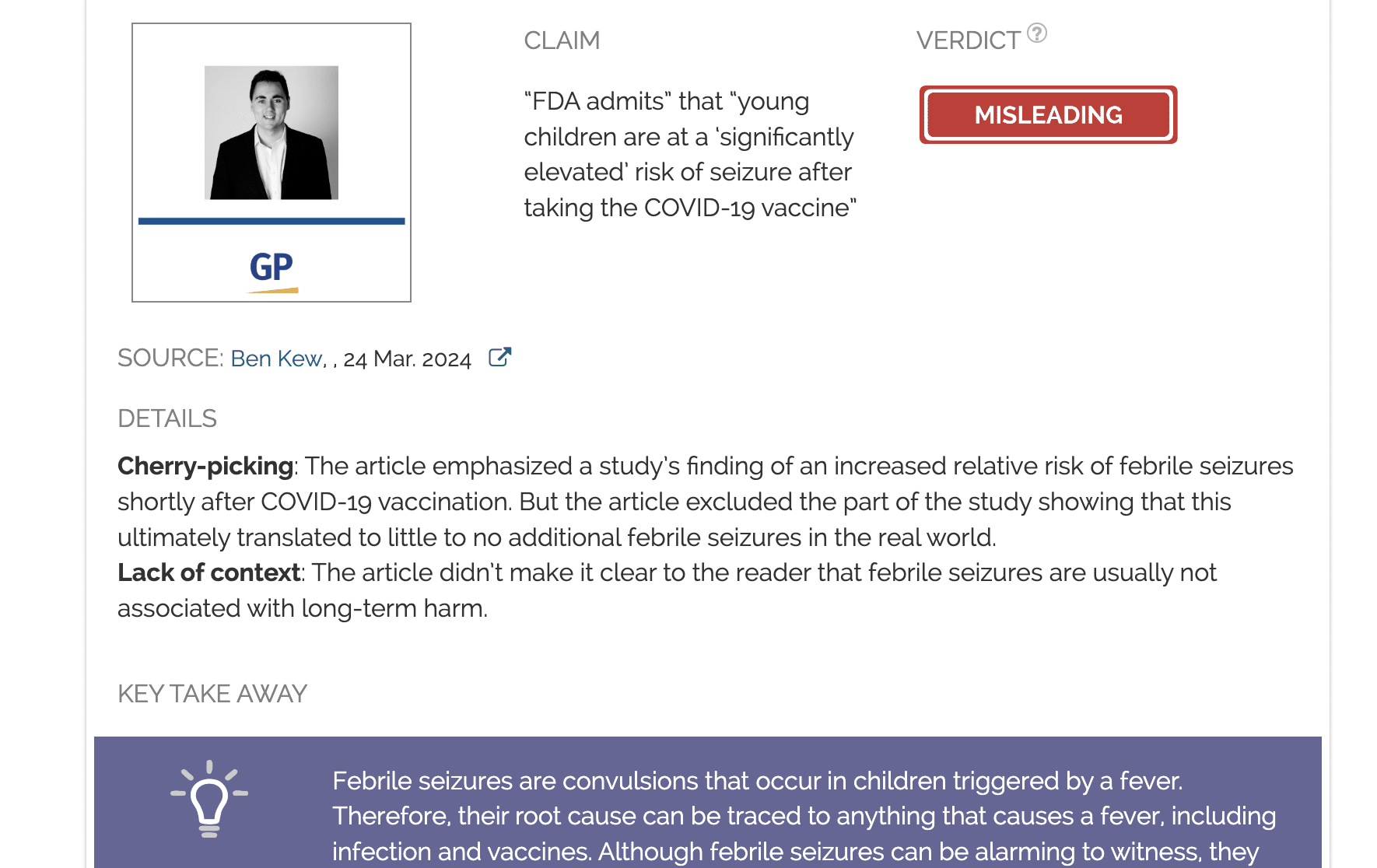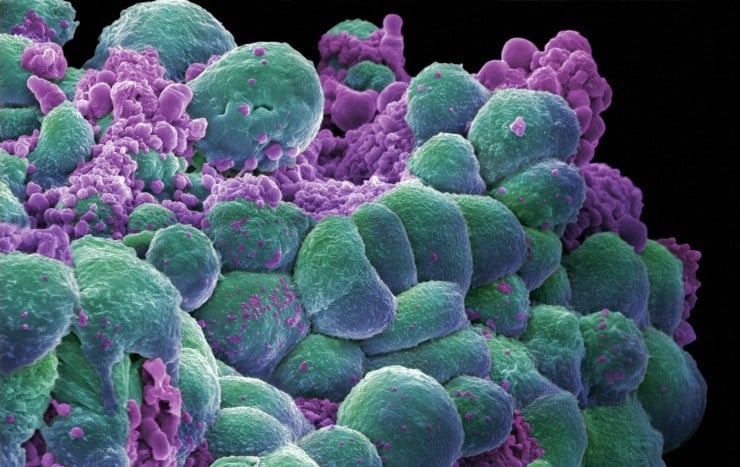- Health
Daily Mail article provides misleading interpretation on South Korean mask study to imply mask-wearing is dangerous
Key takeaway
Scientific evidence shows wearing a face mask reduces the spread of COVID-19. Wearing a face mask also doesn’t significantly impede the exchange of oxygen and carbon dioxide, as gas molecules are many times smaller than the pores of even an N95 mask. COVID-19 is mainly transmitted through infectious liquid particles spread from infected to uninfected individuals. Masks act as simple physical barriers that reduce the dissemination of these liquid particles, which are generated by people when they cough, sneeze, or speak.
Reviewed content

Verdict:
Claim:
“Mask study published by NIH suggests N95 Covid masks may expose wearers to dangerous level of toxic compounds linked to seizures and cancer”
Verdict detail
Factually inaccurate: The study specifically measured the levels of hazardous volatile organic compounds released from KF94 masks and found that these were about 100 to 1,000 times lower than the recommended exposure limit set by the U.S. National Institute for Occupational Safety and Health. This conflicts with the Mail’s claim that the masks “may expose wearers to dangerous level of toxic compounds linked to seizures and cancer”. The study also wasn’t published by the NIH, but by a scientific journal unaffiliated with the NIH.
Full Claim
“Mask study published by NIH suggests N95 Covid masks may expose wearers to dangerous level of toxic compounds linked to seizures and cancer”
Review
August 2023 saw a revival of discussions over a possible return to mask mandates, amid concerns over rising COVID-19 cases. In the wake of this news, a Daily Mail article published on 27 August 2023 claimed that a “mask study published by NIH suggests N95 Covid masks may expose wearers to dangerous level of toxic compounds linked to seizures and cancer”.
To support this claim, it cited findings from researchers at Jeongbuk National University in South Korea. The study, which the Mail article didn’t link to, can be found here. The Mail article has since been shared more than 6,600 times on Facebook, accumulating more than 14,000 engagements.
The researchers studied the levels of chemicals called volatile organic compounds released from commonly-used face masks. Volatile organic compounds, or VOC for short, are commonly manmade chemicals used as industrial solvents. Some of these are used to produce face masks.
KF94 is a Korean standard for face masks: KF stands for “Korean filter”, 94 means that it filters out 94% of particulate matter. KF94 masks are functionally equivalent to N95 masks, which adhere to U.S. standards set by the U.S. National Institute for Occupational Safety and Health (NIOSH).
The aim of the study was to determine if VOC levels in face masks were a health concern, because VOCs have been linked to health problems, depending on how long a person has been exposed to it. In the short term, VOCs can cause eye and nose irritation; chronic exposure on the other hand can increase the risk of developing liver damage and cancer. A total of fourteen masks were tested, of which three were KF94 masks, each of a different brand.
The Mail report misses key finding showing levels of hazardous VOC “nearly 100–1000 times less than the recommended exposure limit set by NIOSH
The Mail’s headline and statements in its report offer readers the impression that the study found dangerously high levels of VOCs from various face masks, suggesting that wearing N95 masks “could cause more harm than good” to people’s health. This is misleading however, and ignores key findings from the study indicating otherwise.
The researchers did report that the total VOC (TVOC) levels released from two of the three KF94 masks (samples B1 and B3) tested fell within the range of high-risk TVOC levels for indoor air set by the German Environment Agency. But they also noted that the TVOC level fell to safe ranges if the masks were removed out of their packaging and allowed to sit in the air for half an hour, an observation that the Mail acknowledged.
The researchers didn’t only examine the total amount of VOCs, they also examined the masks specifically for VOCs corresponding to hazardous chemicals commonly found in work environments, as identified by the United States’ National Institute for Occupational Safety & Health (NIOSH). Among these chemicals are dimethylacetamide and dimethylformamide, cited in the article as “being linked to liver and reproductive damage”.
The study reported that the levels of these hazardous VOCs “were very low, nearly 100–1000 times less than the recommended exposure limit set by NIOSH”.
Therefore, the study’s finding on hazardous VOCs actually conflicts with the Mail’s headline that the masks could expose people to a “dangerous level of toxic compounds linked to seizures and cancer”.
The Mail also claimed that “The Environmental Protection Agency (EPA) recommends keeping TVOC levels below 0.5 parts per million in indoor air”. This formed the basis of the Mail’s claim that the highest TVOC level detected in the tested face masks was “eight times the recommended limit”. No source for this information was provided in the article.
Health Feedback reached out to the EPA to corroborate the claim that the agency established this TVOC standard. In an email, a representative of the EPA’s Office of Public Affairs informed us that they were unable to locate the source of information behind this claim.
The EPA website states that “No federally enforceable standards have been set for VOCs in non-industrial settings”.
In addition, the Mail article reported that the study had examined “toxic volatile organic compounds (TVOC)”. However, the abbreviation TVOC used in the study stands for “total volatile organic compounds”, not “toxic volatile organic compounds”. This error in the article introduces a significant change to the meaning of TVOC that is potentially misleading for readers when interpreting the study.
While KF94 and N95 masks are considered to be functionally comparable, it’s important to note that the study’s results suggest that VOC levels differ depending on the material used to make the mask. Based on the study’s Table 5, the KF94 masks tested in the study were composed primarily of polypropylene and polyurethane nylon. Most N95 masks use polypropylene, according to Meedan’s Health Desk. The study didn’t test any N95 mask, so it doesn’t offer data about N95 masks that allows us to objectively compare VOC levels between N95 and KF94 masks.
Finally, the study was published in the journal of Ecotoxicology and Environmental Safety, not by the U.S. National Institutes of Health (NIH), as the Mail claimed. The journal is part of the MEDLINE database, which is maintained by the U.S. Library of Medicine. That the study is made available on the NIH website doesn’t mean the NIH published it, just as a book being part of a lending library’s collection doesn’t mean it’s published by the library.
Health Feedback reached out to the authors for comment and will update this review if new information becomes available.
On the other studies cited by the Mail
The Mail also claimed that research by the Cochrane Institute showed “face masks made ‘little to no difference’ in Covid infections and deaths”. Health Feedback covered the Cochrane review in question in an earlier review, explaining that the review contained important limitations[1].
For example, it only assessed one benefit of mask-wearing: that of protecting the wearer from infection. But what it didn’t do was determine whether masks reduced the ability of the wearer to infect other people (source control).
The editor-in-chief of the Cochrane Library later released a statement clarifying that claiming “‘masks don’t work” based on the Cochrane review’s results “is an inaccurate and misleading interpretation”.
The Mail article also cited “a controversial study” allegedly showing face masks raise the risk of stillbirths, testicular dysfunction, and cognitive decline in children. This is a reference to a review of published studies aimed at studying the potential effects of carbon dioxide exposure from mask-wearing[2]. As the Mail indicated, the study has been criticized by experts.
Specifically, data scientist Jeremy Howard, an honorary professor at the University of Queensland who examined the data on masks during the pandemic, told PolitiFact that the study overestimated the amount of carbon dioxide people breathe when wearing masks by 60 times.
Howard added that he was “not aware of any research showing that mask usage causes serious health problems”, explaining that many jobs require people to wear masks for an extended period of time. “If there was such a link, we would have clearly seen it from that data”, he said.
Moreover, the study’s hypothesis that mask-wearing produces harmful effects such as stillbirths and cognitive defects was based solely on rat and mouse studies—it contained no evidence confirming that such effects occur in humans. In brief, the study’s relevance to humans is doubtful.
There’s no evidence that wearing a mask significantly restricts oxygen intake or leads to a dangerous accumulation of carbon dioxide. This would be implausible, since gas molecules are many times smaller than the pores in face masks, even N95 masks[3].
Conclusion
Overall, the Mail article’s representation of the Korean study, used to support its case that masks “may expose wearers to dangerous level of toxic compounds”, is inaccurate and misleading, as it failed to tell readers key findings from the study showing that hazardous VOCs released from the masks were approximately 100 to 1,000 times lower than the recommended exposure limit. Health Feedback explained in several previous reviews how scientific evidence shows wearing a face mask reduces the spread of COVID-19.
UPDATE (6 September 2023):
We updated our review to include a statement from the EPA’s Office of Public Affairs indicating the agency was unable to corroborate the Mail’s claim on the EPA’s recommended indoor TVOC level. This information can be found in the eleventh and twelfth paragraphs.
REFERENCES
- 1 – Jefferson et al. (2023) Physical interventions to interrupt or reduce the spread of respiratory viruses. Cochrane Library of Systematic Reviews.
- 2 – Kisielinski et al. (2023) Possible toxicity of chronic carbon dioxide exposure associated with face mask use, particularly in pregnant women, children and adolescents – A scoping review. Heliyon.
- 3 – Sammanan et al. (2021) Effect of Face Masks on Gas Exchange in Healthy Persons and Patients with Chronic Obstructive Pulmonary Disease. Annals of the American Thoracic Society.



